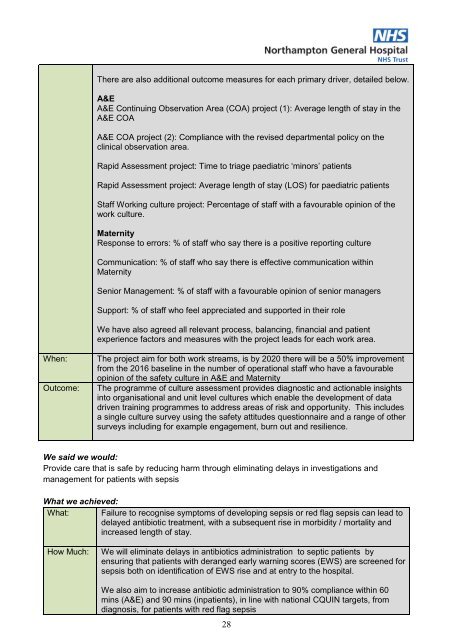Northampton General Hospital NHS Trust Quality Account 2016-2017
Northampton General Hospital NHS Trust Quality account 2016-2017
Northampton General Hospital NHS Trust Quality account 2016-2017
Create successful ePaper yourself
Turn your PDF publications into a flip-book with our unique Google optimized e-Paper software.
There are also additional outcome measures for each primary driver, detailed below.<br />
A&E<br />
A&E Continuing Observation Area (COA) project (1): Average length of stay in the<br />
A&E COA<br />
A&E COA project (2): Compliance with the revised departmental policy on the<br />
clinical observation area.<br />
Rapid Assessment project: Time to triage paediatric ‘minors’ patients<br />
Rapid Assessment project: Average length of stay (LOS) for paediatric patients<br />
Staff Working culture project: Percentage of staff with a favourable opinion of the<br />
work culture.<br />
Maternity<br />
Response to errors: % of staff who say there is a positive reporting culture<br />
Communication: % of staff who say there is effective communication within<br />
Maternity<br />
Senior Management: % of staff with a favourable opinion of senior managers<br />
Support: % of staff who feel appreciated and supported in their role<br />
We have also agreed all relevant process, balancing, financial and patient<br />
experience factors and measures with the project leads for each work area.<br />
When:<br />
Outcome:<br />
The project aim for both work streams, is by 2020 there will be a 50% improvement<br />
from the <strong>2016</strong> baseline in the number of operational staff who have a favourable<br />
opinion of the safety culture in A&E and Maternity<br />
The programme of culture assessment provides diagnostic and actionable insights<br />
into organisational and unit level cultures which enable the development of data<br />
driven training programmes to address areas of risk and opportunity. This includes<br />
a single culture survey using the safety attitudes questionnaire and a range of other<br />
surveys including for example engagement, burn out and resilience.<br />
We said we would:<br />
Provide care that is safe by reducing harm through eliminating delays in investigations and<br />
management for patients with sepsis<br />
What we achieved:<br />
What: Failure to recognise symptoms of developing sepsis or red flag sepsis can lead to<br />
delayed antibiotic treatment, with a subsequent rise in morbidity / mortality and<br />
increased length of stay.<br />
How Much:<br />
We will eliminate delays in antibiotics administration to septic patients by<br />
ensuring that patients with deranged early warning scores (EWS) are screened for<br />
sepsis both on identification of EWS rise and at entry to the hospital.<br />
We also aim to increase antibiotic administration to 90% compliance within 60<br />
mins (A&E) and 90 mins (inpatients), in line with national CQUIN targets, from<br />
diagnosis, for patients with red flag sepsis<br />
28


